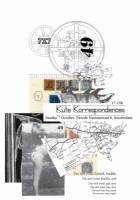07.10.2012 GRA-AWARD RESIDENCY: DANIEL DE ZEEUW
GRA_AWARD prize winner THESIS 2011
Daniel de Zeeuw
presents
Kute Korrespondences
October 7th 2012
05.00 - 07.00 pm
End exam work:
Daniel de Zeeuw, Dogtime ID-UM
Location:
GRA Award Residency, Tweede Nassaustraat 8, Amsterdam
Kute Korrespondences October 7th 2012 05.00 - 07.00 pm
Kute Korrespondences October 7th 2012 05.00 - 07.00 pm
Kute Korrespondences October 7th 2012 05.00 - 07.00 pm

07.10.2012 OPENING:GRA-AWARD RESIDENT: DANIEL DE ZEEUW
05.00 - 07.00 pm
Kute Korrespondences (NL)
Een schrijver-verzamelaar heeft alleen zijn laptop en printer nodig om zijn werk te doen. Samen met deze twee apparaten vormt hij zo een klein universum van ongeveer drie kubieke meter, verbonden met de rest van de wereld middels een ethernetkabel. Vandaar mijn verbazing, toen ik te horen kreeg dat ik vier maanden van het Rietveld atelier gebruik mocht maken. Toch is een atelier niet slechts een ruimte, maar vooral een mechanisme dat de tot gemakzucht neigende geest pest en dwingt zichzelf uit te spreken, en zo uit de comfortabele sferen van dagdroomachtige vorm- en ideeënconstellaties te slepen.
In mijn geval hadden deze constellaties met een specifiek boek te maken, geschreven in 1966 door de Amerikaanse schrijver Thomas Pynchon: The Crying of Lot 49. Op 7 oktober tussen 17:00 en 19:00 ben je van harte welkom om de eerste stappen van dit onderzoek te komen inspecteren, een symbolisch web gesponnen van paranoïde hippies, clandestiene communicatienetwerken, perpetuum mobile machines, dode dassen, geheimzinnige postzegelverzamelingen en luidruchtige engelen.
Daniel de Zeeuw
Kute Korrespondences (ENG)
I invite you to come and check out the first results of my journey into the Mind of a book by the American writer Thomas Pynchon, called The Crying of Lot 49, a confused web consisting of paranoid executrixes, clandestine waste networks, muted posthorns, perpetual motion machines, dead badgers, crazy stamp collections and noisy archangels.
A writer only needs his laptop to write and research. And if he collects pictures he found on the internet, a printer is a nice thing to have. Together with these two machines (and an ethernet cable leading to the outside world) he forms a small universe, a cube of about one by one meter, in whose interstices he must try not to disappear. You can imagine the slight embaressment when I was offered the Rietveld studio for four months (a space ten times bigger than the one I just described). But a studio is not only useful as a space where you can lavish on your fresh paint or clay more freely. It is also an idea, a trigger mechanism that forces and harasses you, to think about the relation between your research and the real world, beyond the enlightened pixels, beyond the textual fragments spread all over your harddrive, as if the thing could only materialize right there, now.
In the beginning of this year I started nourishing and feeding an obsession that was until then only lingering. This obsession revolves around a particular book by the American writer Thomas Pynchon, The Crying of Lot 49 - which when months went by, became less of a definite book and more of a constellation of mystical truths that lay undiscovered under the surface of the story and ultimately under those strange Californean sixties in whose confused Mind it was conceived. In the studio I started laying out and associating the different themes that occur in the book, themes of which at times I'm afraid to ask: are they not splinters of some ancient explosion, of cosmic debris - symbols from times immemorial, when spineless creatures crawled over the earth's rocky surface and chuckled over the animals to come - imagining human beings in cubes of about one by one meter, manipulating and entering strings of symbols into shiny objects.
Daniel de Zeeuw